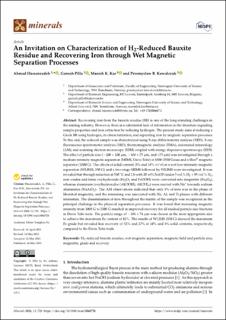| dc.description.abstract | Recovering iron from the bauxite residue (BR) is one of the long-standing challenges in the mining industry. However, there is a substantial lack of information in the literature regarding sample properties and iron extraction by reducing hydrogen. The present study aims at reducing a Greek BR using hydrogen, its characterization, and separating iron by magnetic separation processes. To this end, the reduced sample was characterized using X-ray diffractometry analysis (XRD), X-ray fluorescence spectrometer analysis (XRF), thermomagnetic analysis (TMA), automated mineralogy (AM), and scanning electron microscopy (SEM) coupled with energy dispersive spectroscopy (EDS). The effect of particle size (−200 + 100 µm, −100 + 75 µm, and <75 µm) was investigated through a medium-intensity magnetic separation (MIMS, Davis Tube) at 1000–2500 Gauss and a Slon® magnetic separator (1000 G). The effects of solid content (3% and 10% w/w) in a wet low-intensity magnetic separation (WLIMS, 350 G) and a two-stage MIMS followed by WLIMS were investigated. It was revealed that through reduction at 500 °C and 2 h with 20 wt% NaOH under 5 vol.% H2 + 95 vol.% N2, iron oxides and ferric oxyhydroxide (Fe2O3 and FeOOH) were converted into magnetite (Fe3O4), whereas aluminum (oxy)hydroxides (Al(OOH), Al(OH)3) were reacted with Na+ towards sodium aluminates (NaAlO2). The AM observations indicated that only 3% of iron was in the phase of liberated magnetite, and the remaining was associated with Na, Al, and Ti phases with different intensities. The dissemination of iron throughout the matrix of the sample was recognized as the principal challenge in the physical separation processes. It was found that increasing magnetic intensity from 1000 G to 2500 G resulted in improved recovery for all studied particle size fractions in Davis Tube tests. The particle range of −106 + 74 µm was chosen as the most appropriate size to achieve the maximum Fe content of 41%. The results of WLIMS (350 G) showed the maximum Fe grade but revealed less recovery of 52% and 27% at 10% and 3% solid contents, respectively, compared to the Davis Tube trials. | en_US |

